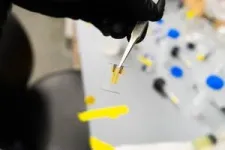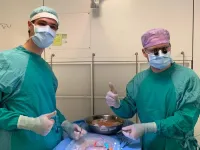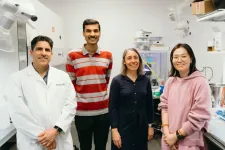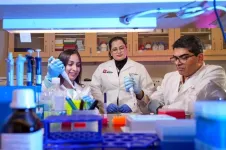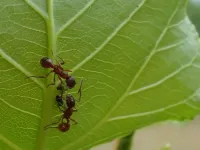(Press-News.org) OKLAHOMA CITY – A new study published in Communications Medicine, a Nature publication, details the discovery of rare gene variants that increase the prevalence of Type 2 diabetes in multiple generations of Asian Indian people. The unusual finding is a step toward more targeted treatment for all people with Type 2 diabetes, a disease with complex genetic influences.
“We wanted to study several generations of Asian Indians because understanding genetics in families can give us better information, and Asian Indians have up to six times higher risk of developing Type 2 diabetes than Europeans. In addition, Asian Indians tend to live clustered together and marry within the same caste system,” which helped us to identify these rare variants, said lead author Dharambir Sanghera, Ph.D., a professor of pediatric genetics at the University of Oklahoma College of Medicine.
“Our study found that the participants have their own rare gene changes, which aren’t found in other unrelated populations around the world,” Sanghera added. “This is important because it helps us understand the different causes of diabetes. It also gives us ideas for creating new medications that target specific proteins or pathways. Treating diabetes in a tailored way is important because not everyone responds well to metformin or other medications that lower blood sugar. Moreover, we need to prevent or delay diabetes in children from families who carry many of these gene changes.”
When people develop Type 2 diabetes, their genes contribute about 50% to the onset of the disease, and the other 50% is due to lifestyle factors such as poor diet and lack of physical activity. There are three main ways genes can affect diabetes: monogenic, where one gene causes the disease; oligogenic, where a few genes have a big impact, regardless of diet or exercise; and polygenic, where some portion of many genes (over 400) each contribute a small effect, combined with lifestyle factors. Scientists have found these genes by studying millions of people, mostly of European descent. The rare gene variations that Sanghera’s team found are an example of oligogenic diabetes, she said.
Sanghera and her team also made an unexpected finding: The gene variants were non-coding. While coding genes are like a “recipe” for building a protein, non-coding gene variants are like “instructions” for when to use the recipe, therefore controlling when and where a protein is made.
“Because these families have multiple generations of diabetes, we thought we would discover coding genes because they directly affect a person’s susceptibility to diabetes,” Sanghera said. “But by finding rare non-coding variants in a handful of genes correlating strongly with diabetes, we realized this is an example of oligogenic diabetes.”
In an incidental finding, the researchers discovered that three of the genes with many rare variations are MODY genes (maturity-onset diabetes in youth). A single MODY gene can cause diabetes (monogenic) no matter how healthy a person’s lifestyle is, Sanghera said. There are about 14 MODY genes that cause this kind of diabetes in young adults, but their link to Type 2 diabetes isn’t well understood.
“These findings suggest we need to study the role of MODY genes in Type 2 diabetes more closely by looking at the genes of families affected by it,” Sanghera said. “The most interesting part of this study was that families with many cases of late-onset Type 2 diabetes and a number of rare non-coding gene changes had fewer common genetic risk factors, known as the ‘polygenic risk score.’ Usually, people with higher polygenic scores have more rare genetic changes.
“The genetic component of diabetes is very complex because the condition is so heterogeneous (has several root causes), just like there are several types of breast cancer and different treatments based on the subtypes of breast cancer,” Sanghera added. “The more we understand about the genetics of diabetes, the closer we move to precision medicine – treating people according to the specific type of diabetes that they have.”
###
About the Project
The study, “Excess of rare noncoding variants in several type 2 diabetes candidate genes among Asian Indian families,” can be found at https://doi.org/10.1038/s43856-025-00750-9. Additional principal investigators on the study include Dileep Kumar K, Rajeev Gupta, Solomon Franklin D. Paul and Ravindranath Duggirala.
This study was supported by grants from the Indian Council of Medical Research Project: No. 55/6/2/Indo-US/ 2014-NCD-II and the National Institute of Diabetes and Digestive and Kidney Diseases grants R21DK105913, R01DK082766 and R01DK118427. Additional support came from the Dr. Geoffrey Altshuler Children Hospital Foundation Endowment Fund and the Presbyterian Health Foundation, both in Oklahoma City.
END
The perfusion technique developed at UMCG to test the quality of donor livers led to a record number of liver transplants last year. Not only in Groningen, but throughout the Netherlands. Meanwhile, there is worldwide interest in this perfusion technique.
Donor livers can only be stored outside the body for a short time, up to 6 to 10 hours. The organ must therefore get to the recipient as quickly as possible. As a result, transplants have always been under great time pressure. The UMCG has had an ‘Organ Preservation & ...
In a breakthrough that could transform bioelectronic sensing, an interdisciplinary team of researchers at Rice University has developed a new method to dramatically enhance the sensitivity of enzymatic and microbial fuel cells using organic electrochemical transistors (OECTs). The research was recently published in the journal Device.
The innovative approach amplifies electrical signals by three orders of magnitude and improves signal-to-noise ratios, potentially enabling the next generation of highly sensitive, low-power biosensors for health and environmental monitoring.
“We have demonstrated a simple yet powerful technique to amplify weak bioelectronic signals ...
INDIANAPOLIS- A team of scientists at the Indiana University School of Medicine has identified that an eye condition affecting the retina, the light-sensing tissue in the back of the eye, may serve as an early indicator for Alzheimer's disease. Their findings, published in Alzheimer's & Dementia, offer new insights into the potential use of retinal changes as early biomarkers for Alzheimer's, which could improve diagnosis and treatment of neurodegenerative disease.
The research was led by IU School of Medicine PhD Student Surabhi D. Abhyankar, MS, alongside colleagues from the school's departments of ophthalmology and biochemistry and molecular biology, the ...
Endophytes: A plant’s friends or foes
Endophytes are microorganisms that live inside plants. Some of these organisms, mostly bacteria or fungi, make the plants sick, while others have no harmful effect on the plants or are even beneficial. Previous studies of endophytic fungi living inside certain grasses have shown that these fungi provide the grasses with a defense against predators. However, little has been known about whether this is also true for trees. The current study investigated the influence of an endophytic fungus of the genus Cladosporium on the herbivore defense of the black poplar Populus nigra, as well as the effects on the insect communities that live on poplars.
"We ...
In a significant advancement for boosting renewable energy generation development, the School of Engineering of the Hong Kong University of Science and Technology (HKUST) has taken the lead in breaking through studies of the nanoscale properties of perovskite solar cells (PSCs). This initiative has resulted in the development of more efficient and durable cells, poised to substantially diminish costs and broaden applications, thereby connecting scientific research with the needs of the business community.
Compared to conventional silicon solar ...
HOUSTON ― The University of Texas MD Anderson Cancer Center’s Research Highlights showcases the latest breakthroughs in cancer care, research and prevention. These advances are made possible through seamless collaboration between MD Anderson’s world-leading clinicians and scientists, bringing discoveries from the lab to the clinic and back.
Study identifies biomarkers for predicting treatment response in metastatic breast cancer
Standard treatment for patients with hormone receptor (HR)-positive, HER2-negative (HR+/HER2-) ...
About The Study: In this cross-sectional study of social media posts about 5 popular medical tests, most posts were misleading or failed to mention important harms, including overdiagnosis or overuse. These data demonstrate a need for stronger regulation of misleading medical information on social media.
Corresponding Author: To contact the corresponding author, Brooke Nickel, PhD, email brooke.nickel@sydney.edu.au.
To access the embargoed study: Visit our For The Media website at this link https://media.jamanetwork.com/
(doi:10.1001/jamanetworkopen.2024.61940)
Editor’s Note: Please see the article for additional information, including other ...
About The Study: In this study, confidence in organizations to use health data responsibly was largely unchanged from 2020 to 2022, but polarization increased between politically liberal and conservative respondents. Compared with 2020, in 2022 liberal respondents reported increased confidence in the federal government to use digital health data responsibly, while conservative respondents reported decreased confidence in the federal government and agencies. Changes in confidence may be related to the prominence of these agencies (CDC, NIH) during the COVID-19 pandemic, a 2020 national election with a change in the governing ...
Influencers are promoting “overwhelmingly” misleading information about medical tests on Instagram and TikTok, according to a global University of Sydney-led study published today in JAMA Network Open.
Researchers analysed almost 1000 posts about five controversial medical screening tests that had been promoted by social media influencers to almost 200 million followers. They found most posts had no reference to scientific evidence, were promotional, had explicit financial interests and failed to mention potential harms.
The ...
Two papers published today in the journal Nature describe a significant advance in understanding the complex functions of the metabolic network. The research is from the lab of Marian Walhout, PhD, the Maroun Semaan Chair in Biomedical Research and chair and professor of systems biology, which has been engaged with fundamental questions of metabolism for more than a decade.
According to Dr. Walhout, organisms constantly monitor their nutrient intake and adjust their metabolism to generate biomass and energy; their ...

